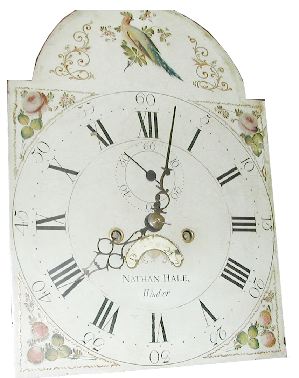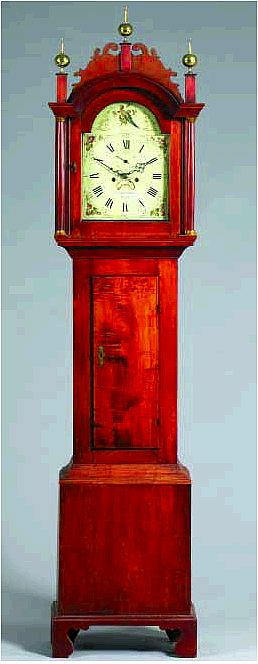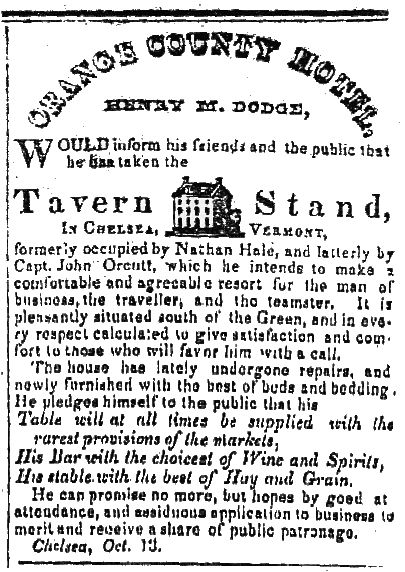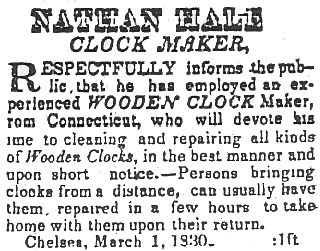Very little about Nathan Hale has been published in the
BULLETIN.
The earliest reference is by James Gibbs, (#184, Pg. 427), who names him a
native of Pindge (sic), New Hampshire, and repeats the assertion
that he apprenticed with Stephen Hassan (sic).
Other references are those in BULLETINs
#250 and #251, the former of which mentions the existence of a Hale
account book, and the latter mentions that several Hale clocks are known
to exist, and BULLETINs #293 and #295;
references to his alleged apprenticeship and his relationship with
Orsamus Roman Fyler.
This account book of the mercantile firm of Nathan and Harry (his
youngest brother) Hale, covering the years 1804-06 in Windsor, now in
the collections of the Windsor [Vermont] Public Library, has very few
references to either clocks or watches. The most interesting entries in
this account book concerning any sort of clock or watch work are
detailed below.3 The first is an account debit against
Nathan in August, 1803, of $5.33 for clock weights bought from someone
named Marsh. In October his account was debited by $51.81 for "12 plain
12 inch clock faces" purchased from Martin Cheney, his erstwhile
primary competitor in Windsor. In November he was credited with an
unspecified amount for cleaning a clock. He was credited with $24.00
for a watch sold to a Captain Bennet in November, 1804. In April of
1805, he was credited with $56.62 for a clock (very likely a tall clock)
sold to a 'Houghton.' In June, 1805, he was debited with $5.58 "to
goods Bot in Boston for clockwork." The following month, he was
credited with 50¢ for having cleaned a clock the previous winter. In
November he was credited with $1.50 for a clockglass, and debited for
$10.03 for "Clockwork bought of Tuckerman & Hazen4 12 Oct."
3These data were excerpted by Charles
S. Parsons, 16 April, 1987, at the Windsor Public Library, and are
available at the NAWCC Library and the American Clock and Watch Museum.
4If anyone, anywhere, knows anything of the firm of Tuckerman
& Hazen, the author would really appreciate the information. An
Edward Tuckerman is listed as a merchant in the Boston City Directory
with a residence at #15 Franklin Place. A George W. L. Hazen is listed
elsewhere as a watchmaker and repairer, ca. 1858 - 1869.
2
It is extremely curious that a clockmaker would so quickly yield his
position to his competition, to the point that he referred his own
customers to Cheney, and later purchased the 12 dials from him. One
wonders just what he did with these dials--were they used on the few
known tall-case clocks? Hale is not debited with the usual purchases of
steel, brass, glass, clock cases, and other items one would expect of
an active clockmaker. Further, why did he purchase "clockwork[s]?"
There are apparently no more than ten clocks of various types which are
known to have been made by Hale. From the above record of his
purchases, and his apparent horological inactivity, the suspicion arises
that he may have purchased the works, the dials, and the cases, put
everything together, and sold the result as a 'Hale.' Let's assume that
he was credited with 50¢ for the "unspecified amount" above. Nathan's
net income in the two year period covered by the account book was
$10.37. For someone who is an alleged "clockmaker," that's not a whole
lot of work on and with clocks, is it?
It's also interesting that Hale was paid $56.62 for a clock. Jedidiah
Baldwin, just up the Connecticut River in Hanover, New Hampshire,
charged $33.00 for an uncased clock, $53.00 for a cased clock--and he
had to make the movement. If Hale paid $4.32 for a dial ($51.81/12),
$10.03 for the movement, $5.33 for the weights, and $12.00 for the case
(as Baldwin did), his costs were $26.68, with little labor involved. A
$30.00 profit with little labor isn't bad at all.
It is even more difficult to believe that Nathan Hale served an
apprenticeship with Stephen Hasham, regardless of Thomas Hale's (Harry
Hale's son, and nephew to Nathan), statement in the keynote address for
the Chelsea Centennial Celebration5 in 1884. A corroborative
note may be found in the 1790 and 1800 census figures for Charlestown,
New Hampshire, and Windsor, Vermont:
1790: Stephen Hasham; 1 male 16 to 25; and 3 females. (The male [age
16+] is Stephen, whose first son was born in 1792--no apprentices.)
1800: Stephen Hasam (sic); 2 males less than 10; 1 male 10 to 16;
1 male 16 to 25; 1 male 26 to 45: 3 young females and wife.
1800: Hale, Nathan, Windsor County, Vermont.
5. CHELSEA Centennial:
Chelsea (Vermont) Centennial Committee:
Proceedings of the centennial celebration of the one hundredth anniversary of the
settlement of Chelsea, Vermont, together with the Orange County Veteran
Soldier's reunion, September 4, 1884.
3
The large number of males in the Hasham household in 1800 would indicate
that there were at least two non-family (Hasham's sons would have been 8
and 3 in that year) members in residence at that time--very likely
apprentices. It is much more likely that these (possible) apprentices
were learning either the carpenter's or bricklayer's trade than
clockmaking. Hasham is given his place in Charlestown's history as an
architect and builder, rather than as a clockmaker. In reflecting on
Hasham's proclivities6, I would deem it highly unlikely that
the newly-wed (on 27 September, 1787) Stephen either wanted or had an
apprentice in his house.
After their sojourn in Windsor, the brothers Hale then surfaced in Chelsea,
Vermont, where land transactions7
are recorded for Nathan and Harry Hale in 1807. Oddly enough, census
data does not place Nathan in Chelsea, Vermont, until 1820, by which
time, according to the Memoirs of Phinehas J. Bailey,
he had long since quit the business of clockmaking8.
Phinehas had moved to Chelsea in 1809 after his seven-month journeyman
service with Jedidiah Baldwin of Hanover, New Hampshire, "...[because I
had] learned that there was one Nathan Hale9 who
formerly worked at the clock business
(author's emphasis) who had some tools to sell." Bailey struck a
bargain with Hale in a partnership wherein Hale would provide the shop,
the tools, and the stock, and he would make clocks "by the halves" in a
partnership that lasted from 1809 to 1816-17. Bailey finally quit the
business in the face of low-priced competition from Connecticut clocks,
claiming that he was "the last brass clockmaker in New England."
6. Stephen Hasham was married twice.
His first wife bore him five children during a 54-year marriage. Less
than four months after her death, Stephen remarried--his bride was a
school teacher of 23--and the couple produced five more children. His
daughter Emily was born when he was 86.
7. Chelsea Town Records, Book 7, Page 470.
Chris Bailey, in Two Hundred Years of American Clocks and Watches
mistakenly places Hale in Chelsea in 1797.
The very short note by James Gibbs in
NAWCC BULLETIN,
No. 184, Page 427, is wholly inaccurate.
8. See Donn Haven Lathrop, "Phinehas Bailey, a Vermont Clockmaker,
Tinker, Inventor, Minister..."
NAWCC BULLETIN,
No. 315, (August 1998): Page 461.
9. "Memoirs of Reverend Phinehas Bailey, written by himself"
and Donn Haven Lathrop, "Phinehas Bailey, A Vermont Clockmaker, Tinker,
Inventor, Minister..."
NAWCC BULLETIN,
No. 315 (April 1995): Page 461.
4
Nathan Hale's own career as a clockmaker must have been rather short,
perhaps covering only the fifteen years--if that--from 1791 to 1806.
There is no specific record of his apprenticeship, whether as a gold- or
silversmith, or as a clockmaker. Parsons and Carlisle both claim (but I
suspect that they might be quoting one another) that Hale apprenticed
with Stephen Hasham of Charlestown, New Hampshire, but Hasham is not
known to have worked in either gold or silver. Hale may have
been one of Stephen Hasham's apprentices, but the only known basis for
this claim derives from the above-mentioned keynote address for the
Chelsea Centennial Celebration in 1884. Thomas Hale, by then the editor
and part owner of the Fitchburg Daily and Weekly Sentinel, in
Fitchburg, Massachusetts, was at 71, too frail physically--and one
wonders about mental frailty as well--to give the speech himself. Edwin
A. Battison (pers. com.) has concluded from his studies of New England
makers and their clocks that Hale more likely apprenticed with the
Hutchins'; therefore this minor controversy may continue to rear its
questioning head. And let us not forget that Peter Davis, a clockmaker
listed in the History of Rindge , was in Rindge in the 1780's.
However, Hasham is thought to have arrived in Charlestown in 1785 (Hale
would have been 14), married in September, 1787; his first child was
born in early 1789. The very idea that Hasham had an apprentice
underfoot during these years verges on the absurd. It is also
interesting to note that in the 1790 census, when Hale would have been
181/2 years old and embroiled in the toils of an apprenticeship,
that but one
male over 16--Stephen himself--is listed in the Hasham household. If
Hale did indeed apprentice with Stephen Hasham, that apprenticeship
would have been much shorter than the expected norm, and he would have
been 'given his time' in the very late 1780's since he advertised that
he was in business as a clockmaker and goldsmith in Rindge by 1791.
His first advertisement reads:
NATHAN HALE, Clock-Maker and Goldsmith, Begs leave to inform
the publick, that, at his shop, near the meeting house in Rindge,
persons may be supplied, on short notice, with warranted Clocks of the
best kind, either with or without cases. Also Gold and Silversmith's
work, of various kinds, made and repaired--as Gold Necklaces--Silver or
plated Buckles, may be made to any pattern, &c. &c.
Customers may depend on being served with honour and fidelity.
Cash given for old Gold, Silver and Brass.
Thomas's Massachusetts Spy: or, The Worcester Gazette,
December 22, 1791.
5
One would expect that Hale, working less than twenty miles north of his
alleged master, would be likely to do more business in the local area,
as did both Martin Cheney in Windsor and Jedidiah Baldwin in Hanover,
New Hampshire. That he did quite a bit of his 'shopping' in Boston,
some 110 miles to the southeast, is not unusual. Local purchases of
clock cases, "old Gold, Silver and Brass," advertisements for an
apprentice, etc., would certainly point to serious activity in
clockmaking in both Windsor and Chelsea, but these indicators are
non-existent since that one advertisement in 1796, in direct comparison
with advertisements by Martin Cheney. Baldwin did business with firms
in New London, Connecticut, and New York City as well as with customers
in the Hanover area--but his primary activity was local.
The History of Chelsea, (Vermont) 1784-1984,
notes that Nathan and Harry Hale came to Chelsea in 1807, based on the
above-mentioned land records, yet only mentions in passing that Nathan
was a clockmaker. One has to take mild exception to Mr. James T. West's
statement10 that Hale "supplemented his clockmaking income
by running a hotel"; it was much more likely the other way around--Hale
was a merchant and innkeeper who bought his movements, dials, and
cases. Perhaps he should be thought of as a "clock assembler," rather
than as a clockmaker. It would be extremely interesting (and perhaps
startling) to examine the movements of his known clocks, in a search for
the "signature(s)" of the maker(s). A resolution could possibly be
achieved through an examination and comparison of known movements by
these various makers--Hale, Hasham, and Hutchins. And who knows?
Perhaps the firm of Tuckerman and Hazen as well...
It is telling that the illustrated tallcase clock (Figure 1) has a
movement that appears to be an import, and that the false plate (and
very likely the dial) are by Wilson of Birmingham, England. Hale is not
known for his cabinetmaking skills; therefore, the case was also likely
a purchase. It is an apparent characteristic of Hasham's clock
movements that the pillars were riveted into the back plate in such a
manner that the ends of the pillars protruding from the plate are domed:
the pillars on this clock have filed-flat rivettings. Perhaps slim
evidence, but there are too many examples of the apprentice faithfully
emulating the master, and this obvious variance, the 12-inch dials
purchased from Cheney (this clock has a 12-inch dial) and the "Clockwork
bought of Tuckerman and Hazen 12 Oct., [1805]" all point to Hale as an
assembler, rather than a maker.
10.
See James T. West, "Vermont Clockmaker Jeremiah Dewey,"
NAWCC BULLETIN,
No. 295 (April 1995): Page 223.
6
|



